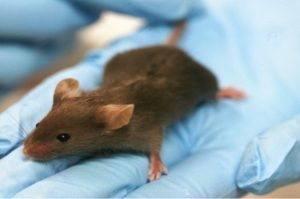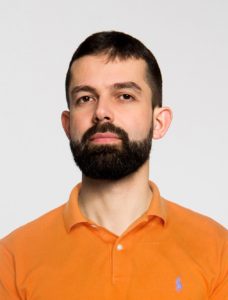Dr. Oksana Piven and her colleagues at the Institute of Molecular Biology and Genetics (IMBG) of the National Academy of Sciences of Ukraine are working on developing a unique technique that, if successful, would restore the heart after a heart attack.
According to the World Health Organization, cardiovascular diseases are the number one cause of death globally. An estimated 17.9 million people died from cardiovascular diseases in 2016. Of those deaths, 85% were due to heart attacks and strokes.
In Ukraine alone, there are 40,000 cases of heart attacks each year. The most common cause is the narrowing of vessels that feed the heart. The process is gradual, but at some point the vessels become blocked, leaving part of the heart without a blood supply. When this happens, the cardiac muscle cells – cardiomyocytes – begin to die rapidly.
If blood supply is restored within two hours, there won’t be much damage to the heart muscle. But if people don’t get help in time, which is often the case, there is a 20% chance of death, and half of those who survive will have a disability.
The cardiac muscle cells that die as a result of a heart attack are replaced by connecting cells – cardiac fibroblasts. In simple language, a scar forms on the heart. Fibroblasts are unable to perform the function of the cardiomyocytes, and the heart is never the same.
While modern medicine can’t repair the heart after a heart attack, research is being done in several areas. For example, Japanese scientists are creating patches from a patient’s stem cells that can be surgically placed on the damaged part of the heart.
Changing cell specialization

Oksana and her colleagues have decided to a try a different approach. What if you turn the fibroblasts of the “scar” back into cardiac muscle cells?
Japanese scientist Yamanaka Shinya was awarded the 2012 Noble Prize in Physiology or Medicine for reprogramming cells. Basically, this is what’s going on:
The human body was once a single cell, formed as a result of the union of a human egg and sperm. The average adult body has 37 trillion cells. All of them are descendants of that first cell and they all have the same DNA. In other words, the nerve cells in the brain and the epithelial cells of our skin have identical genes, but they have a different structure and work differently. That’s because in different cells certain genes are working and others are inactive.
If you know which genes to “turn on,” you can turn any “adult” or specialized cell into a stem cell that can become a different kind of “adult” cell. Or you can “turn on” certain genes and change the “specialization” of the cell. For example, you can turn fibroblasts into cardiomyocytes. This is what Oksana's group is doing.
The theory is that if you “press 5 keys”, or “turn on” 5 so-called cardiac master genes: GATA4, MyoD, Tbx5, Mef2c and HAND2, each of them will force a cascade of other genes to work and the cells will become cardiomyocytes.
Waking up genes
The big question is how do you get these 5 genes to start working in the cell? Well, there are different ways. You can, for example, plant them in special viruses that together will penetrate the necessary cell and start working. This method is being successfully used in experiments on cell cultures. But it’s another matter to apply it to a whole organism, moreover a human one. The side effects can be serious, such as cancer.
That’s why researchers at IMBG decided to do something different – not to introduce master genes from outside, but to wake up those genes already in the fibroblasts. To do this, they’re using CRISPR technology. This special protein complex is often called “genetic scissors” for its ability to find and cut a DNA molecule in the right place.
The Ukrainian researchers are using a modified CRISPR system in their experiments on reprogramming fibroblasts. It finds the right sequence of DNA and instead of cutting it, it forces the genes located there to work.
From mice to humans
 Today, Oksana's group is working with the embryonic fibroblasts of mice. After many attempts, the researchers were able to use CRISPR to activate all 5 cardiac master genes that should transform these cells into cardiomyocytes. Special tests show that the necessary genes have started to work – the proteins encoded in them are being synthesized in the cells. But the cells don’t contract, like normal cardiac muscle cells should.
Today, Oksana's group is working with the embryonic fibroblasts of mice. After many attempts, the researchers were able to use CRISPR to activate all 5 cardiac master genes that should transform these cells into cardiomyocytes. Special tests show that the necessary genes have started to work – the proteins encoded in them are being synthesized in the cells. But the cells don’t contract, like normal cardiac muscle cells should.
“They’re no longer fibroblasts, but they’re not yet cardiomyocytes – they’re something in between,” says Oksana.
There could be several explanations why fibroblasts don’t transform fully. One of them is that the cells need the right environment. In the heart, the cells adjacent to cardiomyocytes send them certain chemical signals.
In the near future, the researchers plan to test how changing the environmental parameters of the cells will change the results of the experiment. After they manage to reprogram embryonic fibroblasts, the experiment will have to be repeated with fibroblasts of adult mice, and then on animals with a modeled heart attack.
If the research is successful, the experiments can be conducted on human cells and ultimately clinical trials can be performed on volunteers. But even in the best case, this is a process that will take more than one year, and of course will require collaboration with other research institutions.
Oksana is reserved in her comments regarding the ability to use the results of this research to treat humans. In the worst case, in her opinion, the treatment simply won’t work, but it won’t harm the patient in any way.
To date, the research has been conducted with a grant from the Science & Technology Center in Ukraine (STCU, grant #6261), but the funding runs out in July and the researchers at IMBG are looking for new sources of funding. They are putting their hope on the National Research Fund, which is supposed to give out funds for research on a competitive basis. However, although the Fund was established, it has yet to begin to work.
You can read more about Oksana's lab at http://www.pivenlab.com.ua/
Photos from Oksana's FB - https://www.facebook.com/opiven
Translated from Ukrainian by USUF

Author: Dmytro Simonov
In Ukrainian
«Відмотати» інфаркт назад
Оксана Півень та її колеги з Інституту молекулярної біології і генетики НАН України працюють над створенням унікальної методики, яка в разі успіху дозволить відновлювати серце людини після інфаркту.
За даними Всесвітньої організації охорони здоров’я причиною смерті №1 у світі є серцево-судинні захворювання. В 2016 році від них померло 17,9 мільйонів людей, причому 85% із них – від інфаркту або інсульту.
Тільки в Україні щороку трапляється 40 тисяч випадків інфаркту. Його найпоширеніша причина – звуження судини, що живить серцевий м’яз. Цей процес відбувається поступово, але в певний момент судина перекривається повністю, тому певна ділянка серця залишається без кровопостачання і м’язові клітини – кардіоміоцити, починають швидко гинути.
Якщо кровопостачання відновити протягом 2 годин, серцевий м’яз не встигне сильно постраждати. Але часто трапляється так, що людина не отримує вчасно допомогу. Тоді з імовірністю 20% вона помре, а половина із тих, хто виживе, житимуть з інвалідністю.
Клітини серцевого м’язу, що відмерли внаслідок інфаркту, заміщуються сполучними клітинами – фібробластами. Кажучи простою мовою, на серці утворюється шрам. Фібробласти не можуть виконувати роботу кардіоміоцитів, тому серце вже ніколи не буде таким, як раніше.
Сучасна медицина не може «відремонтувати» серцевий м’яз після інфаркту, але дослідження йдуть в кількох напрямках. Наприклад, японські науковці створюють латки зі стовбурових клітин пацієнта, які хірургічним шляхом мають накладатися на ушкоджену ділянку серця.
Змінити спеціалізацію
Оксана Півень та її колеги із Інституту молекулярної біології і генетики (ІМБГ) НАН України (Київ) вирішили спробувати інший підхід. Що, якщо перетворити фібробласти, з яких складається «шрам», назад, на клітини серцевого м’яза?
У 2012 році японський дослідник Яманака Сін’я отримав Нобелівську премію в галузі фізіології або медицини за роботи із перепрограмування клітин. Якщо в загальних рисах, то йдеться ось про що.
Кожне людське тіло колись було однією-єдиною клітиною, що утворилася внаслідок злиття яйцеклітини та сперматозоїда. Тіло середньостатистичної дорослої людини складається із 37 трильйонів клітин.
Всі вони – нащадки тієї першої клітини і всі отримали від неї однакові ДНК. Іншими словами, нервова клітина нашого мозку і клітина епітелію шкіри мають абсолютно однакові гени. Але при цьому вони мають різну будову і по-різному працюють. Відбувається це тому, що в різних типах клітин певні гени працюють, тоді як інші гени неактивні.
Якщо знати, які гени слід «увімкнути», можна будь-яку «дорослу» або спеціалізовану клітину перетворити на стовбурову, із якої може утворитися «доросла» клітина іншого типу. Або можна «увімкнути» певні гени і змінити «спеціалізацію» клітини. Наприклад, фібробласт перетворити на кардіоміоцит. Саме цим і займається група Оксани Півень.
Що для цього треба зробити теоретично – відомо. Потрібно «натиснути 5 клавіш», тобто «увімкнути» 5 так званих, кардіальних мастер-генів: GATA4, MyoD, Tbx5, Mef2c та HAND2. Кожен із них змусить працювати цілий каскад інших генів і клітина перетвориться на кардіоміоцит.
Розбудити гени
Інше питання – яким чином зробити так, щоб у клітині почали працювати ці 5 генів? Існують різні способи. Можна, наприклад, підсадити їх до спеціальних вірусів, які разом із ними проникнуть в потрібну нам клітину і там вони працюватимуть. Такий спосіб успішно використовують в експериментах на культурах клітин. Але зовсім інша справа – застосовувати його для цілого організму, тим паче, людського. Побічні ефекти можуть бути надто серйозними, наприклад, онкологія.
Тому дослідники із ІМБГ вирішили зробити інакше – не вносити мастер-гени іззовні, а розбудити ті, які вже є у фібробластах. Для цього вони використовують технологію CRISPR. Це спеціальний білковий комплекс, який часто називають «генетичними ножицями» за його здатність знаходити потрібне місце в молекулі ДНК і саме в цьому місці розрізати її.
Але для експериментів із перепрограмування фібробластів українські дослідники використовують іншу модифікацію системи CRISPR. Вона знаходить потрібну ділянку ДНК, але замість того, щоб різати її, вона змушує працювати розташований тут ген.
Від щурів до людини
Сьогодні група Оксани Півень працює із ембріональними фібробластами щура. За допомогою CRISPR після багатьох спроб дослідникам вдалося активувати усі 5 кардіальних мастер-генів, які мали б перетворити ці клітини на кардіоміоцити. Спеціальні тести показують, що потрібні гени почали працювати – в клітинах синтезуються закодовані в них білки. Але клітини не скорочуються, як це мають робити нормальні клітини серцевого м’яза.
— Це ще не кардіоміоцити, але вже й не фібробласти – це така проміжна стадія, – каже Оксана Півень.
Може бути кілька пояснень, чому фібробласти опираються повному перетворенню. Одне із них полягає в тому, що клітинам потрібне правильне оточення. Адже в справжньому серці сусідами кардіоміоцитів є інші клітини, які надсилають їм певні хімічні сигнали.
Найближчим часом дослідники планують перевірити, як зміна параметрів середовища в якому перебувають клітини, впливатиме на результати експерименту. Після того, як їм вдасться здійснити перепрограмування ембріональних фібробластів, експеримент треба буде повторити із фібробластами дорослих щурів, а потім провести його і на самих тваринах зі змодельованим інфарктом.
Якщо дослідження виявляться успішними, то далі можна думати про експерименти на людських клітинах а, з рештою, про клінічні випробування на добровольцях. Але навіть у найкращому разі, цей шлях триватиме не один рік і, звісно, передбачатиме співпрацю з іншими науковими установами.
Оксана Півень поки стримано коментує можливості застосування результатів цих досліджень для лікування людей. В найгіршому разі, на її думку, таке лікування просто не буде працювати, але ніяк не зможе зашкодити пацієнту.
До нині дослідження проводилися за рахунок грантових коштів Українського науково-технологічного центру (УНТЦ, грант №6162), але фінансування завершується в липні і вчені з ІМБГ шукають нові джерела. Зокрема, вони покладають надії на Національний фонд досліджень, який на конкурсній основі має розподіляти кошти на наукові роботи. Але, хоча Фонд і створено, свою діяльність він ще не розпочав.
Дмитро Сімонов

